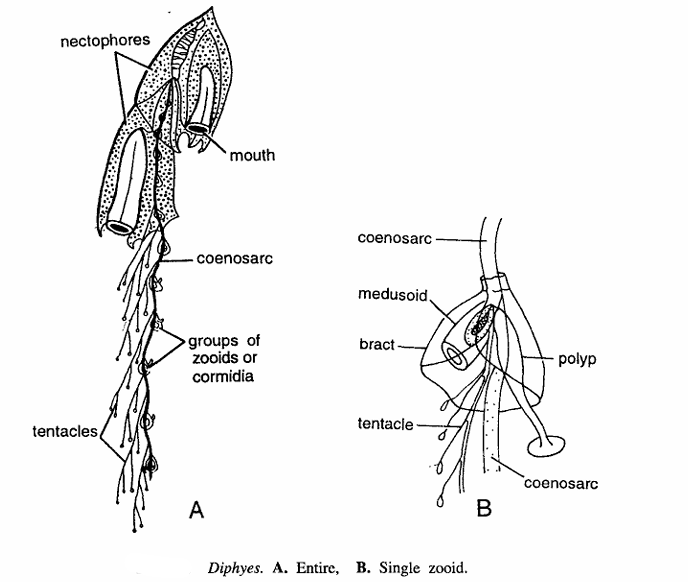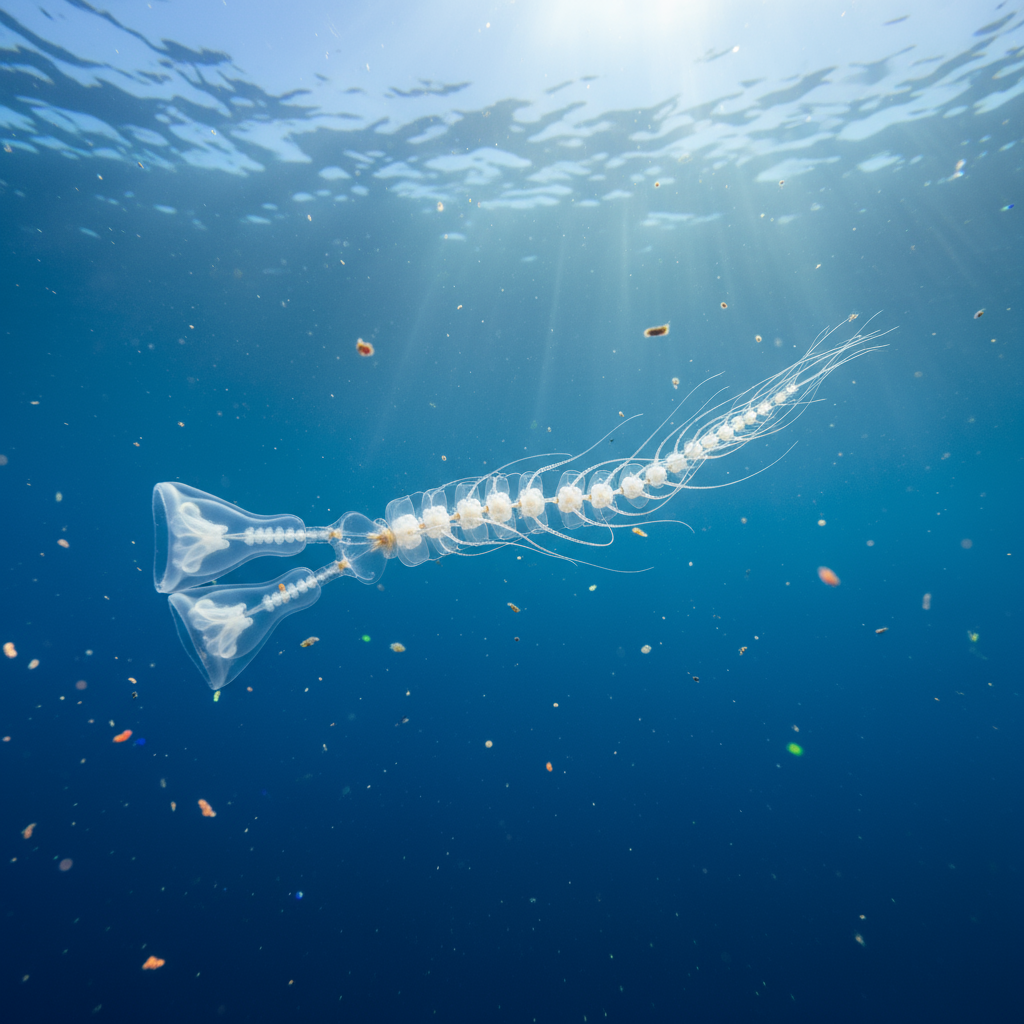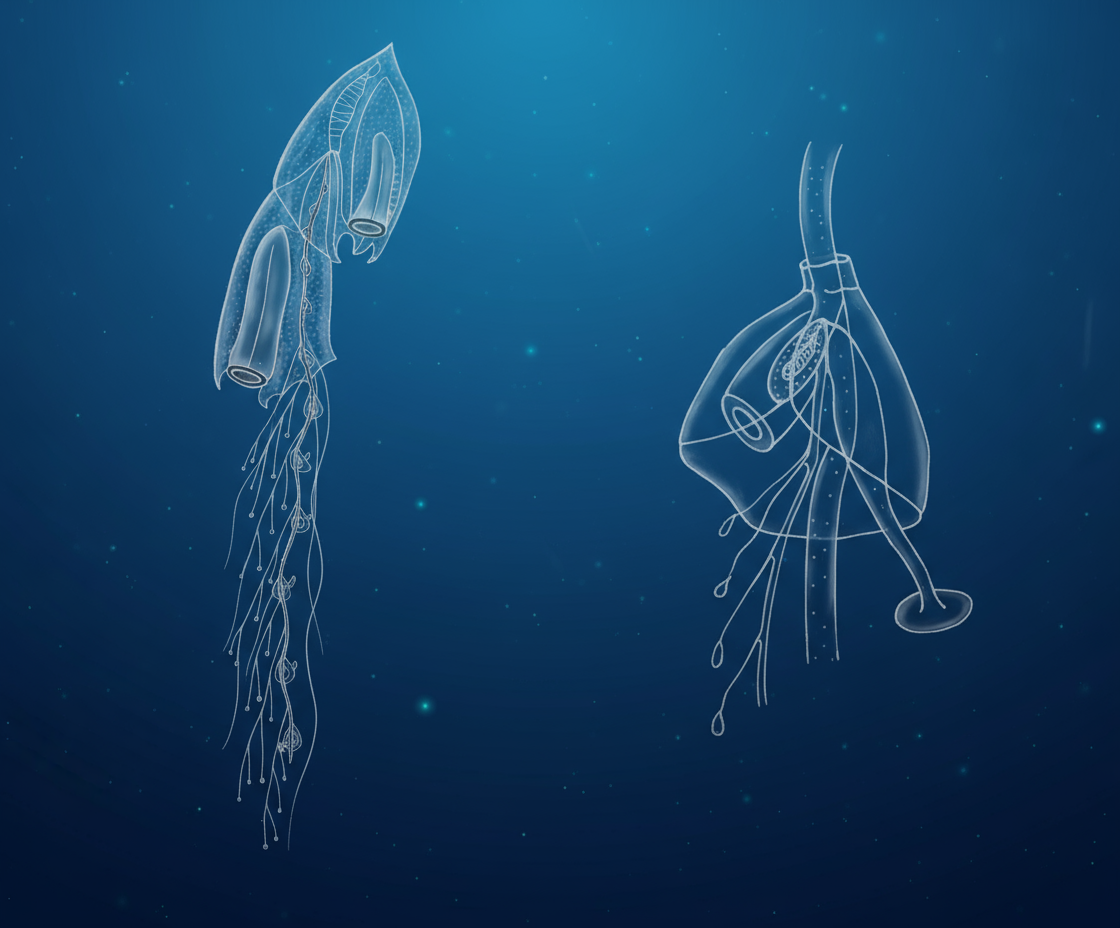Diphyes: Comprehensive Study on Classification, Habitat, Characteristics, and Ecology
Classification of Diphyes
- Kingdom: Animalia — Multicellular, heterotrophic organisms exhibiting cellular specialization
- Phylum: Cnidaria — Radially symmetrical aquatic animals with cnidocytes (stinging cells)
- Class: Hydrozoa — Diverse hydrozoans with polyp and medusa stages
- Subclass: Hydroidolina — Advanced hydrozoans with complex life cycles
- Order: Siphonophorae — Colonial hydrozoans exhibiting polymorphism and specialized zooids
- Family: Diphyidae — Colonial siphonophores with characteristic paired nectophores (swimming bells)
- Genus: Diphyes — Siphonophore genus distinguished by two nectophores arranged sequentially for propulsion

Habit and Habitat
Diphyes are colonial marine hydrozoans inhabiting the epipelagic zone, primarily distributed in open ocean waters from surface to depths of about 500 meters. These float freely in the water column, propelled efficiently by their two longitudinal nectophores—a unique feature among siphonophores.
They form delicate, highly integrated colonies tailored for efficient swimming and prey capture in pelagic habitats. As surface dwellers, they are integral components of planktonic ecosystems affecting prey-predator dynamics in marine food webs.
Geographical Distribution
Diphyes have a cosmopolitan distribution across temperate and tropical oceans worldwide, including Atlantic, Pacific, and Indian Ocean basins. They are most commonly found in subtropical waters but have reported occurrences from Arctic to equatorial regions due to their broad environmental tolerance.
These organisms are often observed in plankton tows during oceanographic surveys, and their presence is indicative of water mass characteristics and productivity.

General Characteristics
- Diphyes is divided into upper and lower parts without pneumatophores.
- Upper part of the colony contains two identical swimming bells or nectophores having tandem arrangement.
- Each bell contains mouth. Lower part represents rest of the colony contmmng widely separated groups of zooids or cormidia.
- Each zooid contains mouth, coenosarc, a hydrophylum, a medusoid form, a polyp or gastrozooid and number of terminally knobed tentacles bract and radial canal.
- Knobed part of the tentacle contains battery of nematocysts.
- The colony is constantly being shortened due to breaking of old and terminal zooids at the internodes.
- Detached zooids are called as endoxia which swim about like independent organisms and later on become sexually mature.
- Colonies consist of specialized zooids including nectophores for locomotion, gastrozooids for feeding, and gonophores for reproduction.
- Two nectophores are aligned linearly, the anterior being larger and containing a somatocyst used for buoyancy regulation by oil droplets.
- Colonies range from a few centimeters to over 30 centimeters in length, appearing as slender, translucent strings.
- Gastrozooids capture small planktonic prey such as copepods and fish larvae utilizing nematocysts.
- The muscular nectosac cavity in nectophores contracts rhythmically to propel the colony.
- Reproductive zooids release medusoid larvae ensuring genetic diversity and colonization.
Special Features
- The paired nectophore arrangement with buoyant somatocysts is an evolutionary adaptation facilitating sustained swimming in pelagic zones.
- High degree of polymorphism among zooids results in a highly efficient division of labor within the colony.
- Colonies exhibit bioluminescence used in communication, camouflage, and predation strategies.
- Sensitive to environmental changes, making them useful bioindicators for oceanic health and climate variations.

Identification
Diphyes can be identified by their transparent, long, string-like colony appearance with two distinct snap-like swimming bells (nectophores) in a linear arrangement. Observations require microscopic examination to study polyp types and somatocyst presence.
Their graceful pulsating movement distinguishes them from other gelatinous plankton.
Ecological Role and Behavior
Diphyes operate as active predators of smaller zooplankton, playing a significant role in controlling plankton abundance and contributing to nutrient cycling. Their swimming behavior influences pelagic ecosystem dynamics, and colonies serve as prey to larger pelagic animals including fish and turtles.
Their population cycles can influence broader marine food webs through trophic cascades.
Human Interaction and Research Importance
While they are not harmful to humans, studying Diphyes contributes crucial knowledge on marine biodiversity, gelatinous zooplankton ecology, and evolutionary biology. Their colonial complexity is a model for understanding multicellularity and cellular differentiation.
Ongoing research investigates their physiology, bioluminescence mechanisms, and responses to climate change.
References
- https://en.wikipedia.org/wiki/Diphyidae
- https://www.sealifebase.se/summary/Diphyes-dispar.html
- http://www.marinespecies.org/aphia.php?p=taxdetails&id=135419
- http://www.marinespecies.org/aphia.php?p=taxdetails&id=135420
- https://mlsu.ac.in/econtents/4190_practical-zoology-invertebrate.pdf
- https://www.turito.com/learn/biology/habitat-grade-10
- https://study.com/learn/lesson/what-is-a-species-characteristics-examples.html
- https://www.turito.com/blog/biology/species-history-definition
